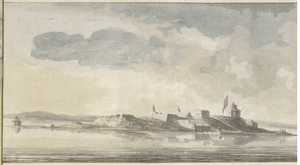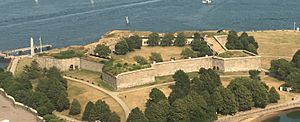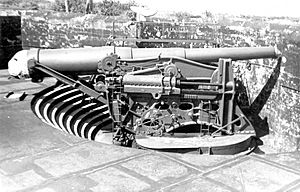Harbor Defenses of Boston facts for kids
Quick facts for kids Harbor Defenses of Boston |
|
|---|---|
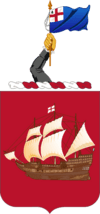
Coat of arms
|
|
| Active | 1895-1950 |
| Country | |
| Branch | United States Army Coast Artillery Corps |
| Type | Coast artillery |
| Role | Harbor Defense Command |
| Part of |
|
| Garrison/HQ | Fort Banks, Winthrop, MA |
| Motto(s) | "Prima Libertatis Acie" (In the First Line of Battle for Liberty) |
| Mascot(s) | Oozlefinch |
The Harbor Defenses of Boston was a special military group in the United States Army Coast Artillery Corps. Its job was to protect the coast of Boston, Massachusetts from 1895 to 1950.
This defense system included large coast artillery forts and hidden underwater minefields. The group started around 1895 as the Boston Artillery District. It was later renamed "Coast Defenses of Boston" in 1913 and then "Harbor Defenses of Boston" in 1925.
Contents
History of Boston's Coastal Defenses
Early Forts Protecting Boston
Colonial Times
The main fort protecting Boston Harbor during the colonial era was Castle William. This site was first fortified in 1634. It was called "the Castle" until 1692, when it was renamed for King William III. It's one of the oldest places in the northeastern United States that has been continuously used as a fort.
The fort was rebuilt and made bigger many times. In 1797, it was named Fort Independence. This fort is on Castle Island, which was connected to the mainland by a road in 1928.
The American Revolution
A big event in Boston during the American Revolution was the Siege of Boston. This lasted from April 1775 to March 1776. The Continental Army, led by George Washington, surrounded the British forces in the city.
The British built several forts, especially on Governor's Island and Noddle's Island. In January 1776, cannons captured at Fort Ticonderoga were brought to Boston. This gave the American Patriot forces much bigger guns.
In March, these new weapons were used to attack the British. A key moment was when the Continental Army took over and fortified fortification of Dorchester Heights. This allowed them to fire on the British ships in the harbor. The British left Boston on March 17, 1776, but they tried to destroy Castle William first.
The Patriots then took over and rebuilt the British forts. This included Castle William (also called Fort Adams) and the forts on Governor's and Noddle's Islands. A new fort was built in 1776 in Hull and named Fort Independence. From 1778-1780, French Marines helped expand this fort.
After the Revolution to the War of 1812
In 1794, Castle William/Fort Adams was repaired. In 1797, President John Adams visited the fort. It was then renamed Fort Independence, and plans were made to completely rebuild it. The fort in Hull lost the name and was called the Allerton Battery.
The new Fort Independence was rebuilt from 1801-1803. It had 42 guns and could house many soldiers. From 1808-1812, Fort Warren (later renamed Fort Winthrop) was built on Governor's Island. After the War of 1812 began, the fort on Noddle's Island was rebuilt as Fort Strong.
From 1816 to 1890
Major new defenses for Boston were built starting in 1833. Fort Independence was rebuilt as a large granite fort, mostly finished by 1848. Another big granite fort, Fort Warren, was started in 1833 on George's Island. The old Fort Warren on Governor's Island was renamed Fort Winthrop. The new Fort Warren was designed for 300 guns and finished in 1861.
Sylvanus Thayer, famous for his work at West Point, oversaw the building of Forts Independence, Warren, and Winthrop.
Boston Harbor was not attacked during the American Civil War. However, the forts were used to gather soldiers, and Fort Warren became a POW camp (a prison camp for captured soldiers). New, powerful Rodman guns were added to the forts during the war.
The Civil War showed that forts made of stone were not strong enough against new, powerful cannons. By the 1870s, plans were made to rebuild the coast defenses. However, funding for new forts stopped in 1879. Fort Independence and Fort Winthrop were put into "caretaker status" around this time, meaning they were no longer actively used as forts.
The Endicott Era
In 1885, a group called the Board of Fortifications was formed. They suggested a complete replacement of the old coast defenses. Most of their ideas were approved, and construction began in 1892 on new forts for Boston. Two underwater minefields also protected the harbor.
Most of these new forts were finished by 1904. Seven forts were needed because of the harbor's complex shape. These included rebuilding parts of Fort Warren on George's Island. The six new forts were Fort Banks and Fort Heath in Winthrop, Fort Strong on Long Island, Fort Andrews on Peddocks Island, Fort Revere in Hull, and Fort Standish on Lovells Island.
These forts had very powerful weapons:
- Fort Banks had sixteen 12-inch (305 mm) mortars. Mortars are guns that fire shells high into the air.
- Fort Heath had three 12-inch guns on special "disappearing carriages." These carriages would lower the gun out of sight after firing.
- Fort Strong had five 10-inch (254 mm) disappearing guns.
- Fort Andrews had sixteen 12-inch mortars.
- Fort Warren was rebuilt with two 12-inch and five 10-inch disappearing guns.
- Fort Revere had two 12-inch guns.
- Fort Standish had four 10-inch guns.
Smaller guns were also placed to protect the minefields. As these new forts were built, Forts Independence and Winthrop were no longer used after 1908.
Some guns were quickly added in 1898 when the Spanish-American War started. It was feared that the Spanish fleet might attack the US east coast. In 1917, during World War I, some of these guns were moved away.
World War I
When the United States entered World War I, many changes happened to the Coast Artillery. Many temporary buildings were put up at the forts for the soldiers. The Coast Artillery was the only part of the Army with experience using large cannons. So, they were chosen to operate most of the heavy and railway artillery (cannons on train cars) in the war.
Soldiers from the forts were sent to the Western Front in Europe. Some guns were removed from the forts to be used in the war. For example, 8-inch, 10-inch, and 12-inch guns were turned into railway artillery. 5-inch and 6-inch guns became field guns on wheels.
Not many railway artillery pieces were used in battle before the war ended. The 5-inch and 6-inch guns were sent to France, but their units didn't finish training in time. After the war, the 5-inch guns were removed from service, but many 6-inch guns were stored and used again in World War II.
Some mortars and 10-inch guns were removed from Fort Banks, Fort Andrews, and Fort Warren. Three 6-inch guns and all 5-inch guns were removed from Fort Revere and Fort Andrews.
During and after World War I, anti-aircraft (AA) batteries were built at some forts. These had 3-inch (76 mm) guns to shoot down enemy planes. Some of these guns were used until early World War II.
Between the World Wars
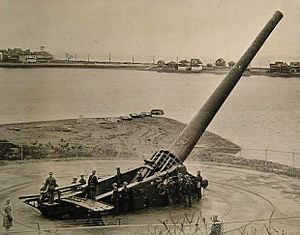
In 1920, many older weapons were removed from the forts. On July 1, 1924, the harbor defense groups changed from being organized by companies to being organized by regiments. On June 9, 1925, their names changed from "Coast Defenses..." to "Harbor Defenses...". The 9th Coast Artillery was the main Regular Army group for Boston's defenses.
A new ship channel opened in the northern part of Boston Harbor. To protect this new area, Fort Ruckman was built in Nahant from 1918 to 1924. It had two 12-inch (305 mm) guns that could shoot much farther than older guns. These guns were designed to fight against new, powerful battleships.
Boston was also chosen for one of the first 16-inch (406 mm) gun batteries in the United States. This was Fort Duvall on Hog Island (now Spinnaker Island), built from 1919-1927. It had two huge 16-inch (406 mm) guns that could fire shells very high and far. This allowed them to hit the decks of enemy warships from above.
World War II
At the start of World War II, many temporary buildings were built again for the soldiers. The old Fort Winthrop was torn down in 1941 to make way for Logan Airport.
After the Fall of France in 1940, the Army decided to replace most old heavy guns with 16-inch guns. Fort Ruckman and Fort Duvall were covered with concrete "casemates" to protect them from air attacks. In 1942, construction began on the East Point Military Reservation in Nahant. This included Battery Murphy with two 16-inch (406 mm) guns. This battery started working in 1944, helping Fort Ruckman protect the northern harbor. Another 16-inch battery was built at Fort Dawes on Deer Island, but it was never armed.
New 6-inch (152 mm) batteries were also built. These had strong concrete bunkers for ammunition and fire control. The guns were protected by open shields. Many of these guns were the same 6-inch guns that had been removed in World War I and stored. Four of these batteries were built in the Boston area.
Two batteries with 155 mm (6.1 inch) guns were set up quickly in 1942. These guns were towed and placed on circular concrete platforms. They were located at the East Point Military Reservation in Nahant and the Sagamore Hill Military Reservation near the Cape Cod Canal.
Four 90 mm gun batteries were built to fight against enemy torpedo boats. These guns could shoot at both ships and planes. They were completed in 1943 at Fort Heath, Fort Standish, Fort Revere, and Great Brewster Island.
As new defenses were built, and with little threat to the east coast, most of Boston's older heavy guns were removed and scrapped in 1942-43. Only a few 6-inch guns remained until the end of the war. Many forts in the Boston area, like Fort Andrews, were used as POW camps during World War II.
The US Navy also helped protect Massachusetts Bay with nets and special loops to detect submarines.
After World War II
After the war, it became clear that gun defenses were no longer useful. They were scrapped by the end of 1948. In 1950, the Coast Artillery Corps and all Army harbor defense commands were closed down. Today, the Air Defense Artillery carries on the history of some Coast Artillery units.
In the late 1940s, anti-aircraft gun sites were set up, and later Nike missile systems were deployed. Some of these sites were at or near the old Coast Artillery forts, like the East Point Military Reservation and Fort Strong.
Present Day
Today, the forts around Boston are in different conditions. Some are well-preserved, while others are completely gone.
Fort Independence is easy to visit and is very well-preserved. It's a public park with tours in the summer. The former East Point Military Reservation in Nahant is now a science center for Northeastern University and is open to the public. You can still see the 16-inch gun battery there. Fort Ruckman in Nahant is partly buried but still visible.
Fort Banks in Winthrop is also partly buried, but sometimes opens for special events. Fort Heath in Winthrop has been completely removed.
Most of the forts on the harbor islands are part of the Boston Harbor Islands National Recreation Area. You can take a ferry to visit most of them. Fort Warren on George's Island is very well-preserved and offers guided tours. It's a unique example of an old fort with newer batteries added. Fort Standish on Lovells Island and Fort Andrews on Peddocks Island can also be reached by ferry.
Fort Strong is not currently accessible because the bridge to Long Island was taken down in 2014. Fort Revere in Hull is a park, and its 6-inch batteries are well-preserved. Fort Duvall on Spinnaker Island has houses built on it, but one 16-inch gun spot is still visible. Fort Dawes was completely removed to build a water treatment plant.
The former Fourth Cliff Military Reservation in Scituate is now an Air Force recreation area. You can still see the World War II 6-inch battery and some fire control towers there. Many other fire control towers are in the Boston area, mostly privately owned.
Coat of arms
- Blazon
- Shield: Red, with the ship Mayflower sailing.
- Crest: On a silver and red wreath, an arm holding a staff with the flag of Bunker Hill.
- Motto: PRIMA LIBERTATIS ACIE (In the First Line of Battle for Liberty).
- Symbolism: The red shield stands for the Artillery. The Mayflower, the crest, and the motto all represent Boston's important history.
- Background: This coat of arms was first approved in 1919 for the Coast Defenses of Boston. It was later approved for the 9th Coast Artillery Regiment in 1924.


